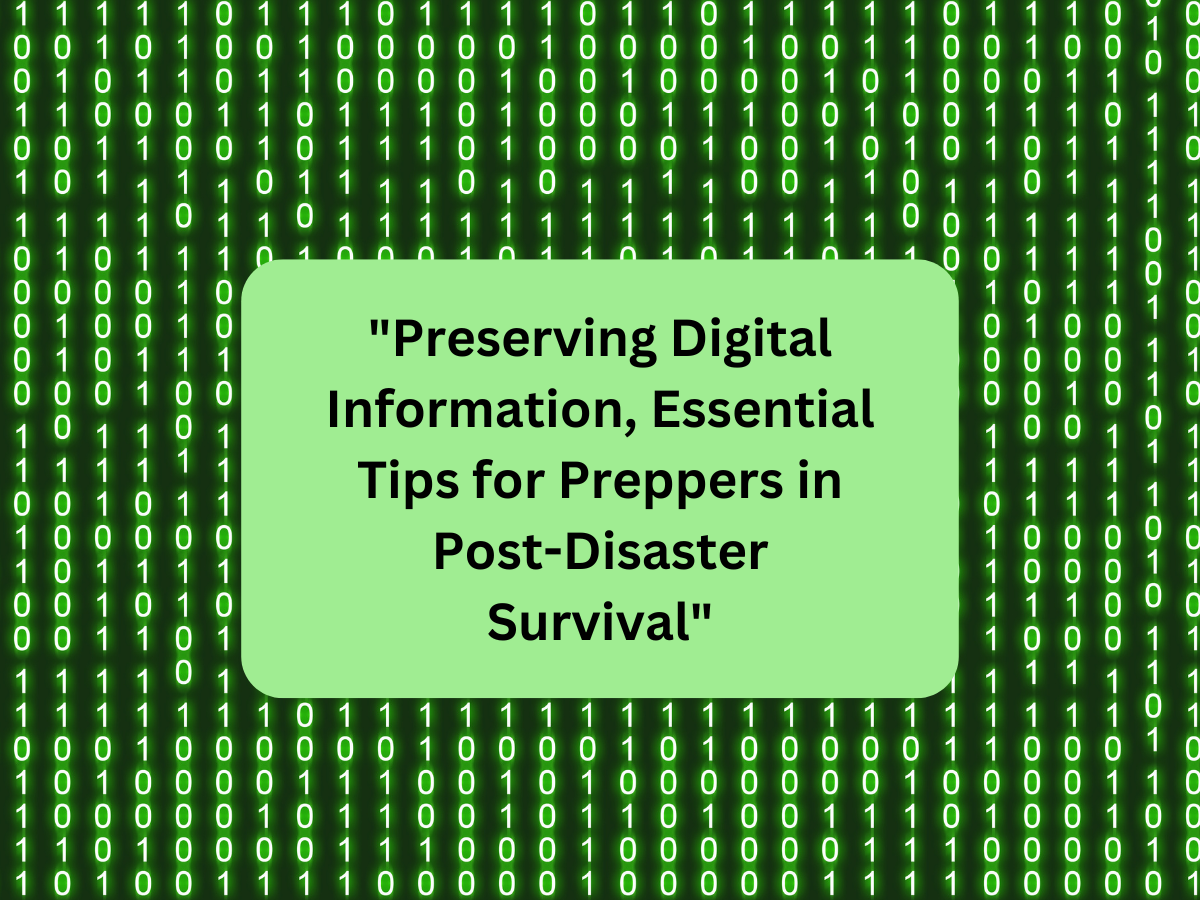Have you ever wondered what you’d do if a disaster struck and you lost all your crucial digital information? In our increasingly digital world, the mere thought is enough to send shivers down any prepper’s spine. With our dependency on digital data skyrocketing, it’s more important than ever to ensure our critical information is safe, no matter what comes our way.
Think about it: government records, personal documents, treasured photos, and vital survival resources all stored digitally – what happens if a disaster wipes them all out? Without proper preservation strategies, we could be left in the dark, losing not just data but our way of navigating a post-disaster world. This is why preserving digital information has become a crucial aspect of preparedness for those who want to stay ahead of the curve, ready for any uncertainties that life might throw at us.
Post Contents
ToggleThe Importance of Preserving Digital Information
In an increasingly digital age, the importance of preserving digital information cannot be overstated. Imagine a sudden disaster wiping out all your crucial digital data. How would you cope? This section discusses why it’s vital to save digital information, focusing on its significance in a post-disaster context.
Historical Context: Discuss past instances where loss of data had significant impacts on society
Throughout history the loss of data has had profound impacts on society. One glaring example is the Yahoo data breach which occurred between 2013 and 2016, exposing over 3 billion user accounts. This breach didn’t just affect individuals but had wide-reaching consequences for online security.
Another significant event was the billion data records lost or stolen in 2014, marking a 71 percent increase over the previous year, according to the History of Data Breaches. Businesses faced immense financial and reputational damage, which underscores the criticality of data preservation.
In recent decades, we’ve seen companies crippled by data loss, shedding light on the detrimental impacts this can have on operations and trust. The 15 biggest data breaches of the 21st century not only emphasize the immediate effects but serve as a cautionary tale about the broader social implications.
Types of Digital Information to Preserve: Enumerate the kinds of data that are critical
Preserving digital information in a post-disaster world isn’t just about holding onto old photos or emails; it’s about maintaining the very fabric of our daily lives. Here are some vital types of data to consider:
Personal Records
- Birth certificates, passports, and marriage licenses.
- Health records and medical histories.
Financial Information
- Bank details, investment records, and tax documents.
- Insurance policies and property deeds.
Survival Guides
- Emergency contact lists.
- Manuals on first aid, home repair, and survival tactics.
Maps and Geographic Data
- Local topographical maps.
- GPS coordinates and navigation information.
Communication Logs
- Important emails and contact lists.
- Logs of significant communications with family, friends, and authorities.
Ensuring these types of data are preserved in a secure and accessible manner can be the difference between chaos and order in a crisis. Having these crucial elements at your fingertips can help navigate the uncertainty and dangers of a post-disaster environment, providing a semblance of normalcy and control.
In summary, the preservation of digital information is paramount for anyone looking to prepare for unforeseen disasters. The historical context of past data losses demonstrates the wide-reaching effects, and understanding the types of information to prioritize helps ensure your readiness for any situation.
Strategies for Preserving Digital Information
In a post-disaster world, preserving digital information becomes paramount. Various strategies can ensure your data remains intact and accessible, no matter the circumstances. Let’s dive into some effective ways to safeguard your digital assets.
Cloud Storage Solutions
Cloud storage has revolutionized how we store and access data. It offers numerous benefits, making it a popular choice for preserving digital information.
- Accessibility: Cloud storage allows you to access your data from anywhere in the world, as long as you have an internet connection. This is particularly useful in a disaster scenario where physical access to storage devices might be compromised.
- Scalability: You can easily scale your storage space without the need to purchase additional physical hardware.
- Automatic Backups: Many cloud storage services provide automatic backups. This ensures that your data is frequently updated and protected against loss.
However, it’s not without its drawbacks:
- Security Concerns: Storing data in the cloud means it’s vulnerable to cyber-attacks. Ensuring you pick a service with strong security measures is vital.
- Internet Dependency: Cloud storage requires a stable internet connection to access and store data, which may be challenging post-disaster.
For more details, you can explore the benefits and drawbacks of cloud storage.
Physical Storage Options
While cloud storage is excellent, it’s equally essential to have physical storage solutions:
- External Hard Drives: These devices offer significant storage capacity and can be easily transported. They’re great for larger files but can be damaged by physical shocks or water.
- USB Drives: USB drives are compact and perfect for storing essential documents and smaller files. They’re generally robust but can still break under extreme conditions.
- Durability: Some physical storage devices, like rugged external hard drives, are specifically designed to withstand natural disasters. Always check the durability before purchasing.
If you want to read more about the durability of physical storage devices, check out this resource.
Data Encryption
Encryption is a critical component in protecting your data. It ensures that only authorized individuals can access your information, even if the data is compromised.
In a chaotic post-disaster environment, sensitive information can be at risk:
- Security: Encrypting your data protects against theft and unauthorized access. It’s like putting your data in a safe that only you have the key to.
- Peace of Mind: Knowing your data is encrypted provides peace of mind, reducing one worry in an already stressful situation.
To dive deeper into why encryption is crucial, check out this guide.
Redundancy and Backups
Redundancy and backups are the bedrock of data preservation. Having multiple copies of your data ensures it remains safe even if one storage solution fails.
- Redundancy: Store your data in various locations—both cloud and physical. Redundancy means you’ll always have a backup, no matter what.
- Regular Backups: Schedule regular backups to keep your data current. Automate this process where possible to minimize oversight.
For further reading, explore the importance of redundancy and backups.
Incorporating these strategies can make a huge difference in protecting your digital information in a post-disaster world. From cloud storage to physical devices and encryption to backups, each method plays a crucial role in ensuring your data’s safety.
Technologies and Tools for Data Preservation
Preserving digital information in a post-disaster world is crucial. Without proper tools and strategies, we risk losing valuable data forever. Let’s explore the technologies and tools available for data preservation, ensuring we have access to our information when we need it most.
Offline Storage Solutions
Offline storage solutions are essential in disaster scenarios where internet connectivity is compromised. Here are some effective tools and methods:
External Hard Drives: These are reliable for storing large amounts of data. They can be easily transported, making them perfect for emergency situations. It’s like having a portable vault for your digital treasures. Check out some durable options on the market.
USB Flash Drives: Compact and durable, USB drives are ideal for storing smaller files and important documents. Their portability and ease of use make them a great tool for preppers exploring USB drives for their data safety.
Optical Discs (CDs/DVDs): While seeming a bit old school, optical discs are resistant to electromagnetic disturbances and are excellent for long-term storage. Make sure to store these in a cool, dark place to extend their lifespan.
Paper Backups: For critical documents, having printed copies is still a wise move. Although it’s not a digital solution, it’s a reliable backup that technology can’t always replace.
Offline Backup Software: Tools like Acronis and Veeam allow for comprehensive backup solutions that don’t rely on the cloud. They provide options to create full system images stored on external drives, ensuring you have a ready-to-go backup no matter the circumstances.
Despite the advancements in cloud storage, offline solutions ensure that your data is safe and accessible even when technology fails.
Data Recovery Solutions
Data recovery is just as important as data preservation. Disasters can lead to data loss or corruption, so having the right tools to retrieve this information is crucial:
Ontrack Easy Recovery: This tool offers comprehensive data recovery services. From accidental deletion to hardware failure, Ontrack has solutions tailored for various data loss scenarios. It’s like having a digital detective ready to restore your precious data exploring advanced recovery tools.
Disk Drill: Known for its user-friendly interface, Disk Drill supports recovery from a wide range of formats and devices. Whether it’s a crashed hard drive or a corrupted file, Disk Drill simplifies the recovery process significantly.
Recuva: A free tool that can effectively recover lost files from hard drives, memory cards, and external drives. Its quick and deep scan options provide a thorough approach to data recovery, making it a handy solution for preppers.
CleverFiles: This Mac-friendly tool is excellent for recovering data from various storage devices. Whether it’s a Mac’s SSD or an external hard drive, CleverFiles helps ensure your digital information is not lost forever discover useful recovery techniques.
Seagate File Recovery Software: This software is specifically designed to work with Seagate products but also supports other brands. It provides a robust suite for data recovery, ensuring you can retrieve lost files efficiently.
In addition to these tools, it’s wise to maintain regular backups and employ redundancy strategies. By storing data in multiple locations and using a variety of recovery tools, you ensure that your information is never out of reach, even in the worst situations.
Utilizing these offline storage solutions and advanced data recovery tools ensures that you’re well-prepared to preserve digital information, safeguarding against the inevitable uncertainties of a post-disaster world.
Best Practices for Preppers
As preppers, we know the importance of being ready for any situation that may arise. When it comes to preserving our digital information, there are several best practices to follow. Let’s explore these to ensure that our vital data is always protected and accessible, even in a post-disaster scenario.
Regular Updates and Maintenance
Regular updates and maintenance of your digital storage systems are crucial. Think of it like maintaining a car – without regular oil changes, it will eventually break down. The same goes for your digital storage.
Why is this so important?
- Security: Regular updates ensure that your systems are protected against the latest threats. Cyber-attacks evolve quickly, and outdated software can be a major vulnerability. Always make sure your antivirus and operating systems are up to date.
- Functionality: Updates often come with performance improvements and bug fixes. Keeping your systems updated can prevent data loss due to software issues.
- Storage Health: Regularly check the health of your storage devices. Hard drives and SSDs can degrade over time, so running diagnostic tools will help you catch issues before they lead to data loss.
Skip regular updates, and you might find yourself scrambling for lost data at the worst possible time.
Creating a Digital Survival Kit
Creating a digital survival kit can be a lifesaver when disaster strikes. This kit should include all the essential data, tools, and instructions you might need. Here’s what to consider including:
Essential Data:
- Personal Documents: Scan and save copies of ID cards, birth certificates, passports, and insurance documents.
- Medical Records: Have a digital copy of important medical records and prescriptions.
- Financial Information: Securely store bank account details, credit card information, and essential tax documents.
- Legal Documents: Ensure you have digital copies of wills, deeds, and contracts.
Tools:
- Data Recovery Software: Tools such as Ontrack Easy Recovery and Disk Drill can help you recover lost data.
- Encryption Software: Use encryption tools to protect sensitive information. Keeping data safe from unauthorized access is like locking it in a digital safe.
- Backup Solutions: Ensure you have both cloud and physical backup options. External hard drives and USBs are great portable solutions.
Instructions:
- Emergency Contacts: Keep an updated list of emergency contacts.
- Survival Guides: Store digital copies of survival handbooks and first aid manuals.
- How-To Guides: Include instructions on how to use your backup and recovery tools. If something goes wrong, it’s vital to know how to fix it.
Consider your digital survival kit as a lifeboat for your information, ready to keep you afloat when disaster disrupts your normal systems.
By adhering to these best practices, you can be confident that your digital information is prepared for any emergency. Remember, staying proactive and prepared today can prevent significant headaches tomorrow. Stay safe, preppers!
Conclusion
Preserving digital information is not just a technical task; it is a crucial preventative measure for anyone serious about preparedness. From cloud and physical storage strategies to data encryption and regular backups, every step counts in ensuring that critical information remains accessible even when disaster strikes.
By prioritizing the preservation of digital data, preppers can safeguard essential records, guides, and communication logs that could be vital in a crisis. The importance of this cannot be overstated – it’s about maintaining our ability to function and make informed decisions when the unexpected occurs.
Remember, investing time and resources into effective digital preservation today can make an immense difference in navigating the chaos of a post-disaster world tomorrow. Stay prepared, stay informed, and most importantly, keep your digital information secure.





